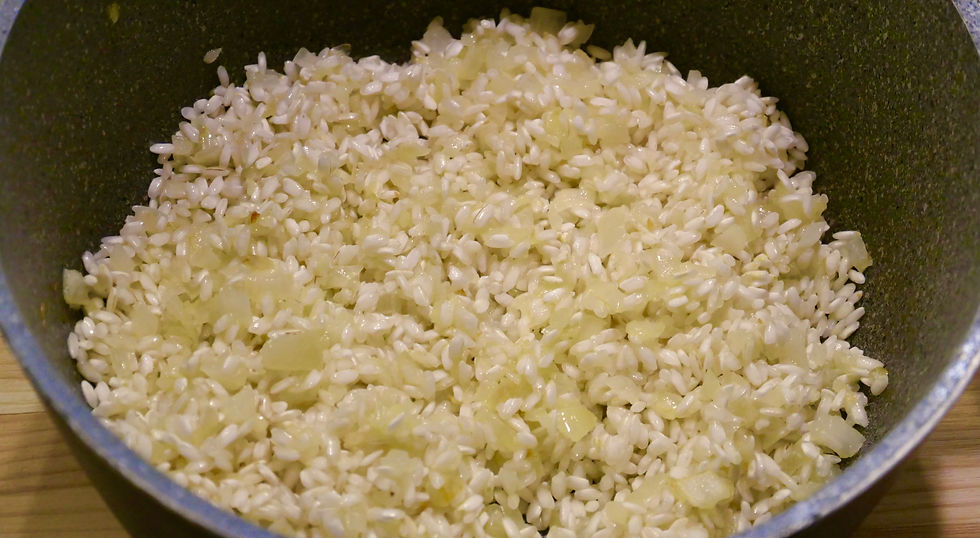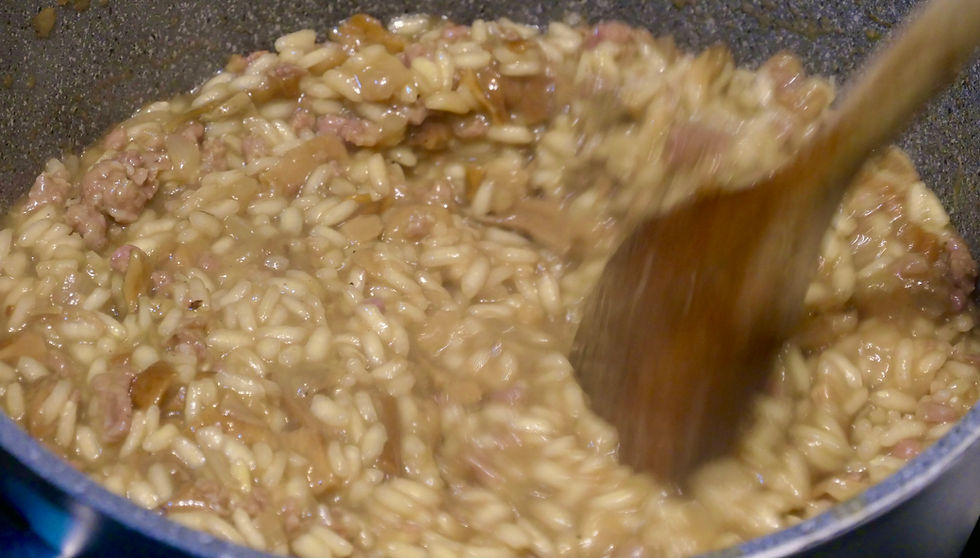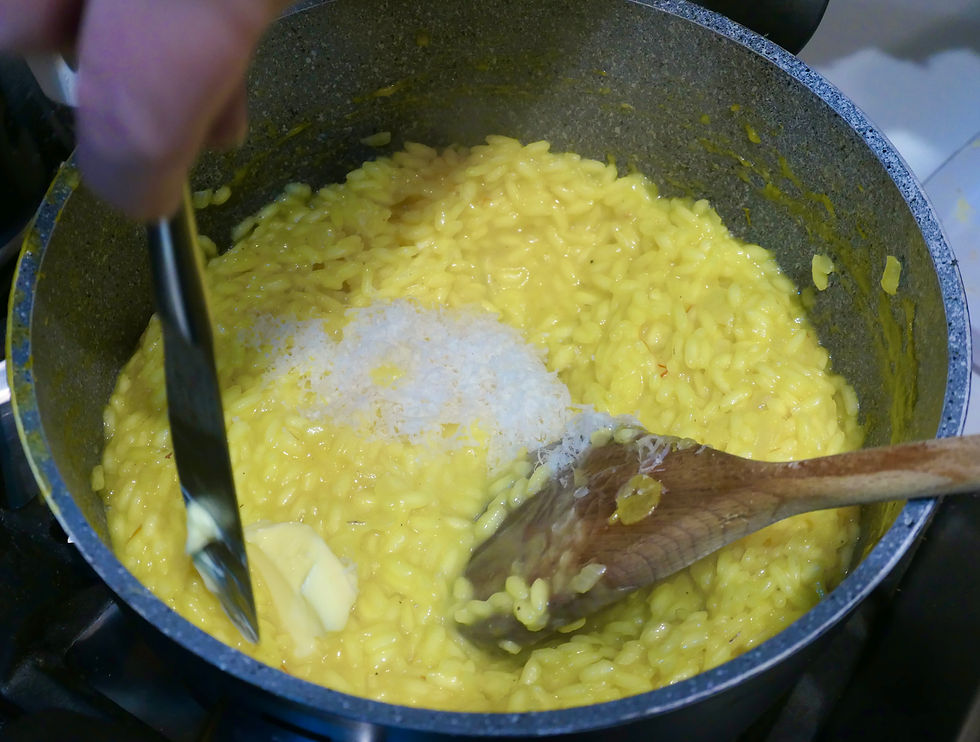When Italians mention riso (rice) they’re talking about risotto because this is the only way that most Italians eat rice and the cooking method differs from every other national cuisine. The risotto technique is almost the exact opposite of how the Spanish cook paella and has nothing in common with Chinese stir fry, Japanese sticky rice, Cajun dirty rice or Basmati rice dishes.
The great thing about a risotto is that you can put together a healthy, filling and tasty meal where everything is cooked in just one saucepan. Furthermore, you need only one fresh seasonal ingredient which could be a single vegetable like asparagus, zucchine, fennel, artichokes or pumpkin. Alternatively one type of seafood like shrimps, scallops, clams or any type of fish fillets would make a good risotto. Equally a simple risotto could be made using mushrooms, truffles or saffron or even just cheese. Many risotti are a combination of ingredients but they don’t have to be.
You won’t see many traditional Italian risotto recipes designed around meat as the main ingredient, except for sausage perhaps, but away from formal recipes there is no reason why pieces of leftover meat can’t be used in a risotto.
One of the most famous risotto recipes, Risotto allo Zafferano (saffron) has an absolute minimum amount of ingredients so a risotto doesn’t have to be complicated. The best way to describe the risotto process is to split it into the essential steps that are common to all types of risotto and these could be categorized as follows using the Italian terminology, because you only need one word in Italian whereas in English the translations are always less succinct:
riso (type of rice), brodo (stock), soffritto (sautéing the initial ingredients), tostatura (toasting the rice), cottura (cooking process) and mantecatura (beating in the butter and cheese at the end).

Riso
The most common types of rice used in Italy are Arborio and Carnaroli, in that order. Carnaroli has a higher starch content and firmer texture than arborio and keeps its shape better. Carnaroli is also more attractive in the final presentation as it becomes translucent so for all these reasons it is our first choice followed by another variety Vialone Nano in second place and then arborio last if the others are not available.
Italy grows these and several other varieties of rice in significant quantities across the Pianura Padana in Piedmont, Lombardy and Emilia Romagna.
Brodo
As rice is neutral with respect to flavor, the purpose of the stock in a risotto is not just to provide the liquid with which to cook the rice (because hot water could do that simple task) but also to enhance the flavor of the main ingredient. It follows therefore that a bad stock or the wrong stock is either going to ruin the flavor or smother the flavor of a delicate risotto. For this reason you should try to make your own stock.
For more robust risotto dishes we make a simple chicken stock in sufficient quantity to freeze it in 3 cup (three quarter liter) containers, each of which is sufficient for a two person risotto, or for a more delicate vegetable risotto we make it fresh each time because it’s really not much effort.

A simple vegetable stock is made with onion, carrots and celery and perhaps some parsley stalks and leaves because they’re often in the fridge. And you would typically add to this some parts of the vegetable that is being used for the main ingredient that would otherwise be discarded.
For example, for an asparagus risotto you would add some of the thicker woody ends to the stock or for a fennel risotto you’d use some of the coarser outer layers of the bulb in the stock; all of which would otherwise be discarded. Instead you’re now adding to and enhancing the flavor base of the dish. You can also add a handful of spinach or Swiss chard and some frozen peas but nothing with too strong a flavor or color like beetroot.
It's better not to add garlic or salt to the stock because these and other ingredients are best left to the actual process of making the risotto as quantities will vary according to the specific type of risotto.
For two people use just under 1 liter of water, add the roughly chopped ingredients, bring to the boil and then simmer for 45 minutes. Strain and it's ready to use.
Soffritto
Once the stock is ready and all the solid matter removed it’s time to start the risotto. The soffritto in this case is often simply a small finely chopped onion sautéed gently in a saucepan sufficiently large to hold the rice, the stock and the other ingredients for that particular recipe.
Because risotto is a dish from northern Italy the onion is usually sautéed in butter but olive oil can be used or a combination of the two. Don’t allow the onion to brown and the only other thing to add at this stage is whatever ingredient requires the full 20 minutes cooking time at a highish temperature. Of the various types of risotto we make it’s usually only sausage that we would add at this time as in the recipe Risotto ai funghi porcini e salsiccia.

Tostatura
When the onion has been sweating gently for about 5 minutes, add the rice and turn the heat up high. Stir continuously for a minute or two until all the rice is coated with the onion and butter mixture and warmed through.
Add half a glass of white wine and let the alcohol burn off for half a minute until the rice becomes a little dry again.
Cottura
From this point until the rice is cooked will take around 18 minutes and whatever the main ingredient is, it should be cleaned, chopped and ready to add at the appropriate time. The specific risotto recipe will address this part of the process.

Start by adding a full ladle of hot stock to the risotto and now you’ll need to stay by the stove and stir regularly until the rice is fully cooked.
Add the stock to the risotto one ladle at a time whenever the rice starts to dry out but don’t drown the rice by adding too much at once.
After 15 minutes check for salt and start tasting the rice to determine when it’s full cooked. If you run out of stock keep some boiling water on hand to keep the process going because cold water will reduce the temperature and affect the timing. Add smaller quantities of stock at this point because you don’t want to be left with a soupy mess when the rice is fully cooked.
Mantecatura
Once all the ingredients are added and the rice is cooked turn the heat off, let it rest for a minute and then with a wooden spoon vigorously beat into the risotto some cold butter from the fridge and then, if called for in the recipe, the cheese (never in a seafood risotto).

This will usually be Grana padano in the north of Italy or Parmigiano reggiano in Tuscany and elsewhere.
Check for seasoning one last time and serve straight away because otherwise the residual heat in the pan will continue to cook the rice. Shallow bowls or even flat dinner plates are best for a risotto so it can cool enough to eat. The consistency of a perfect risotto should be all’onda (like a wave); it should not be soupy and it should not be so stiff that you can stand your fork up in it.